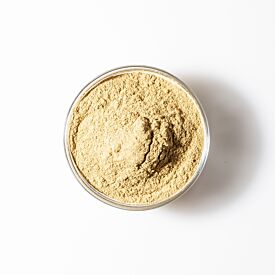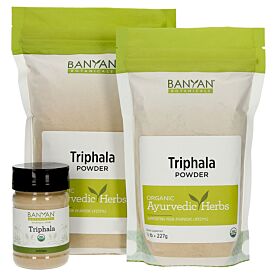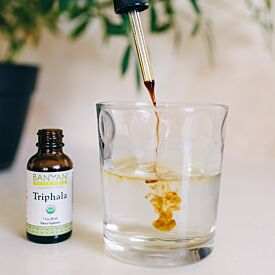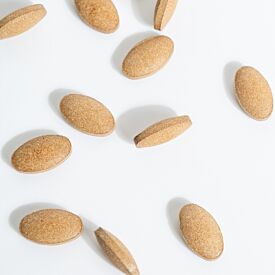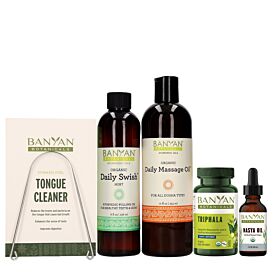Which Form of the Herb Is Best for Me?
Choosing which form of an herb to take can be quite confusing! There are tablets, liquid extracts, powders, teas, drink mixes, and more.
In Ayurveda, there is no right or wrong way to take an herb—the most important thing is that you take them!
With that understanding, each form of the herb has specific benefits that are helpful to take into consideration when choosing an herb or herbal formula. This article is intended to help you figure out which method of delivery will be most beneficial for you, depending on your needs and preferences.
Please recognize that it is not always as simple as what is described below, and finding the right form of herb can take some personal experimenting. Be patient with the process and remember, the most important thing is to find what works best for YOU.
Herbal Tablets
They are easy to take. Many of our formulations, which are precise blends of herbs with a specific purpose, come in tablet form. This is an easy and convenient way to get that perfect combination of herbs, especially when you’re on the go or traveling. Not everyone has time or patience to measure out the powder, and if you are in a rush, spilling herbal powder on your clothes can really hold things up!
They offer a taste of the herb. Banyan offers tablets as opposed to capsules so that you can at least get a quick taste of the herbs (for reasons we explain in the following section) before swallowing them. For those who have difficulty swalling pills and do not mind the taste of the herbs, the tablets are also chewable.

Herbal Powders
They provide the whole herb in its innate form. Traditionally, the powder of the plant, whether it be of the root, or fruit, or leaves, is what the ancient Ayurvedic practitioners used in their formulations. They recognized that plants have an innate intelligence and contain everything needed for proper absorption, digestion, and assimilation.
This is why Banyan provides whole-plant herbal powders and avoids the now popular practice of extracting specific constituents from the herbs—Ayurveda teaches that all parts of the plant work synergistically to give a balanced effect.
Take turmeric for example. The main active constituent, curcumin, is the talk of the town since its many benefits have been widely researched. But it is only 5 percent of the whole root of turmeric, which has over 300 other constituents! Several studies have shown that the whole plant has greater benefits than curcumin alone, including greater immune function and stronger natural antioxidant function.1, 2
They allow you to taste the herb. Powders are great if you have the time to measure out and take the appropriate amount of herb. In Ayurveda, it is said that digestion begins in the mouth with taste. This is a scientific fact—the tongue communicates directly with the brain and other parts of the body and sends important information based on the taste it receives.3 So while some herbs are more palatable than others, tasting them is very beneficial to the digestive process.
They adapt to your needs and lifestyle. Powdered herbs can easily be added to food or drinks. For instance, you can sprinkle some hingvastak on your meals, soak any of the herbs in water to make a cold decoction (triphala is a prime example), or boil the herb in water or other liquids to make a hot decoction or tea.
Some choose to add ashwagandha to their smoothies, or cook shatavari and other spices with ghee for additional nourishing properties and digestibility. Powder is very versatile, making it easy to take in any way that suits your needs!
Liquid Extracts
They provide a concentrated form of the active constituents. Liquid extracts are made by a process of distilling the beneficial properties of the whole herb in alcohol or glycerin, resulting in a more concentrated form. As a result, you do not need to take as much of the liquid extract. For instance, 15 milligrams (mg) of ground herb is roughly equivalent to one drop of liquid extract.
They are potent and fast-acting. Most of Banyan's liquid extracts are in a base of alcohol and water, modeled after the traditional form of extracts, asavas and arishtas, where herbs were fermented in an alcohol base. Asavas and arishtas were recommended in traditional Ayurveda when an immediate result was sought, because the sharp and heating qualities of alcohol help the herbs act quickly and directly in the body.
Both of Banyan's alcohol and glycerin-based liquid extracts allow the body to assimilate the active constituents found in the liquid rapidly and thoroughly. The heating nature of the alcohol is also helpful for those with a weaker digestive fire, where digesting whole herbs on its own is often challenging. That being said, alcohol-based extracts are probably not the best idea when there is a strong pitta imbalance.
They are easy to take. Liquid extracts provide an alternative way to take your herbs if you do not want to bother with the hassle of powders or if you are not a fan of swallowing multiple tablets at once. They are easy to mix with a small amount of water or juice and drink on the go.
They have a long shelf life. Liquid extracts have a longer shelf life, as compared to herbal powders or tablets, while other forms of herbs slowly lose their potency through evaporation, oxidation, and degradation.
Teas and Drink Mixes
They provide the taste of the herb in their whole form. Banyan’s teas and drink mixes are designed to deliver whole herbs, along with all their benefits, in carefully formulated blends that can be enjoyed throughout the day. As discussed above, tasting the herbs helps to activate the digestive process and support proper assimilation and absorption.
They are versatile and delicious. Our teas and drink mixes have been carefully crafted to deliver herbs in a way that is easy, beneficial, and delicious. While taking herbal supplements can sometimes feel like a chore, drinking these tasty herbal blends provides a delightful daily ritual that you will find yourself looking forward to—even craving!
Teas and drink mixes also lend themselves to endless variations, so you can find the perfect herbal recipe to fit your taste. You can keep it simple by adding the herbs to hot water or get as fancy as you choose by blending your herbs into delectable herbal latte drinks with milk, honey, and ghee.
We encourage you to try different forms herbs to find the right fit for you. Give each form a couple weeks to really get a sense of how it is acting in your body. Taking this time to cultivate a relationship with your herbs can be a deeply satisfying experience!
Enjoy the process of discovering what works best for you. And if at any point you would like more personal guidance, we encourage you to work with an Ayurvedic practitioner who can assist you along your way.




